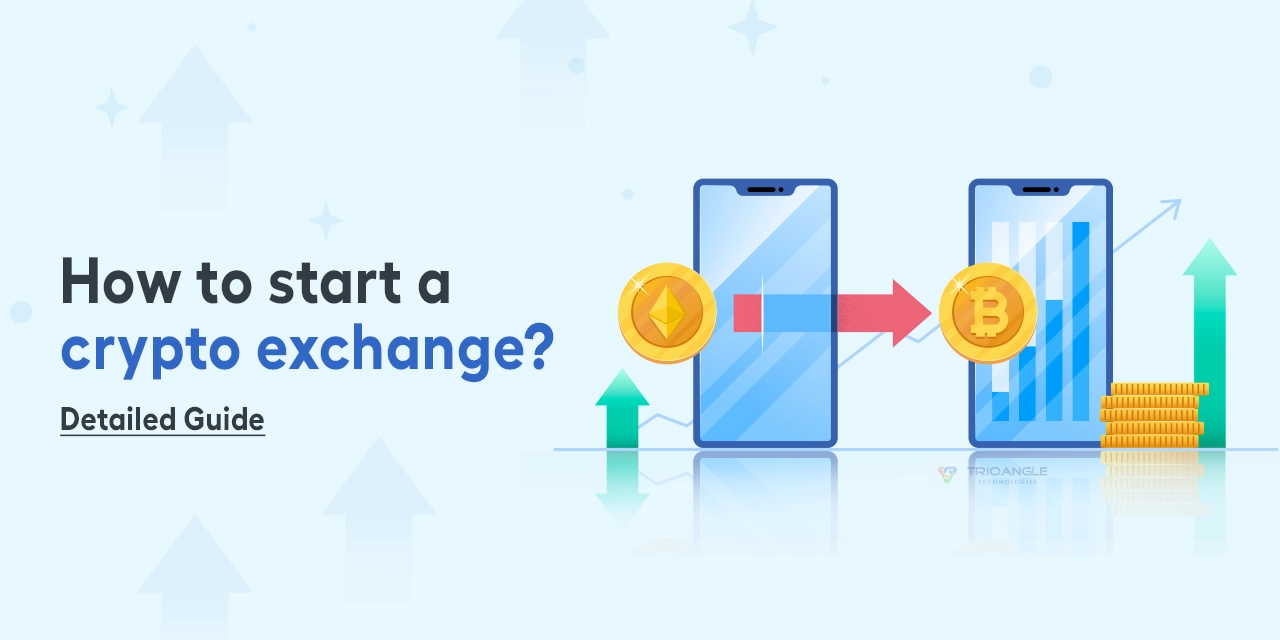Starting your crypto exchange platform can be a promising venture in the dynamic world of cryptocurrencies. With the increasing adoption of digital assets and the growing demand for secure trading platforms, launching a crypto exchange requires meticulous planning, technological expertise, regulatory compliance, and a strategic approach to attract users and liquidity.
What is a Cryptocurrency Exchange Platform?
A cryptocurrency exchange platform is an online marketplace where users can buy, sell, and trade cryptocurrencies. These platforms serve as intermediaries that facilitate transactions between buyers and sellers of digital assets like Bitcoin, Ethereum, and various altcoins.
Cryptocurrency exchange platforms play a crucial role in the broader adoption and trading of digital currencies, providing a secure and efficient way for individuals and institutions to participate in the crypto market.
How Cryptocurrency Exchange Platform Works
Working as the digital marketplace for users who are willing to trade cryptocurrencies. Cryptocurrency exchange platform is a seamless option. The workflow of the cryptocurrency exchange platform is depicted as follows:
Step 1: Account Creation
Creating an account and the registration are the initial steps. This comprises identity verification and compliance with the KYC/AML regulations.
Step 2: Funds Deposit
Users deposit fiat currencies (USD, EUR) or cryptocurrencies (Bitcoin, Ethereum) into their exchange account
Step 3: Order Placement
Users place orders on the platform to buy or sell cryptocurrencies. Orders can be market orders (executed immediately at the current market price) or limit orders (executed when the price reaches a specified level).
Step 4: Order Matching
The exchange matches buy and sell orders from its users. For example, if a user wants to buy Bitcoin at a certain price and another wants to sell at that price, the exchange facilitates the trade.
Step 5: Execution
Once an order is matched, the exchange executes the trade. The purchased cryptocurrency is transferred to the buyer’s account, and the sold cryptocurrency or fiat currency is transferred to the seller’s account.
Step 6: Withdrawal
Users can withdraw their cryptocurrencies or fiat currency from the exchange platform to their personal wallets or bank accounts.
Step 7: Security Measures
Cryptocurrency exchanges implement robust security measures such as encryption, two-factor authentication (2FA), cold storage for storing funds offline, and regular security audits to protect users’ assets.
Step 8: Market Analysis & Tools
With the inclusion of price charts, trading volumes, and order books, the cryptocurrency exchange platform helps users make informed decisions quickly.
Step 9: Regulatory Compliance
Exchanges must comply with regulations specific to their operating jurisdictions, which may include reporting requirements, tax compliance, and customer protection measures.
Cryptocurrency exchange platforms provide a crucial infrastructure for trading digital assets, offering liquidity, security, and accessibility to participants in the global cryptocurrency market
How to Create a Cryptocurrency Exchange Platform
Creating a cryptocurrency exchange platform is a complex process that requires careful planning, technical expertise, and compliance with regulatory standards. Here’s a step-by-step guide to help you through the process:
1. Conduct Market Research and Planning
- Market Analysis: Understand the current market trends, user demand, and competitive landscape.
- Target Audience: Identify your target users, such as retail traders, institutional investors, or specific geographic markets.
- Business Model: Decide on the type of exchange (centralized, decentralized, or hybrid), revenue streams (transaction fees, listing fees, premium features), and core functionalities.
2. Legal and Regulatory Compliance
- Jurisdiction Selection: Choose a jurisdiction with favorable regulations for cryptocurrency exchanges.
- Legal Structure: Establish a legal entity for your exchange and consult legal experts to ensure compliance with local and international laws.
- KYC/AML Policies: Implement robust Know Your Customer (KYC) and Anti-Money Laundering (AML) procedures to comply with regulations and enhance security.
3. Choose the Right Technology
- Cryptocurrency Exchange Software: Decide whether to build your platform from scratch or use a white-label solution. Consider factors like scalability, security, and customization.
- Blockchain Integration: Select a blockchain platform that suits your needs for security, speed, and scalability.
- Development Team: Hire experienced developers or partner with a cryptocurrency exchange development company to build your platform.
4. Develop Core Features
- User Authentication: Implement secure user registration and login processes, including two-factor authentication (2FA).
- Trading Engine: Develop a robust trading engine that matches buy and sell orders efficiently.
- Wallet Integration: Integrate secure cryptocurrency wallets for storing digital assets. Use cold storage for the majority of funds to enhance security.
- Payment Gateway: Set up payment gateways for fiat deposits and withdrawals, ensuring compliance with financial regulations.
- User Interface (UI): Design an intuitive and user-friendly interface that caters to both novice and experienced traders.
5. Implement Security Measures
- Encryption: Use advanced encryption methods to protect user data and transactions.
- DDoS Protection: Implement Distributed Denial of Service (DDoS) protection to safeguard against attacks.
- Regular Audits: Conduct regular security audits and penetration testing to identify and fix vulnerabilities.
- Cold Storage: Store the majority of funds in offline wallets to protect against hacking attempts.
6. Testing and Quality Assurance
- Beta Testing: Conduct beta testing with a small group of users to identify bugs and gather feedback.
- Performance Testing: Ensure the platform can handle high volumes of transactions without performance issues.
- Security Testing: Test all security measures thoroughly to ensure the platform is secure from potential threats.
7. Launch and Marketing Strategy
- Soft Launch: Begin with a soft launch to a limited audience to test the platform in a live environment.
- Full Launch: After addressing any issues from the soft launch, proceed with a full-scale launch.
- Marketing Campaign: Develop a marketing strategy to attract users, including digital marketing, social media promotion, partnerships, and community engagement.
- Referral Programs: Implement referral and affiliate programs to incentivize user growth.
8. Ongoing Maintenance and Support
- Customer Support: Provide 24/7 customer support to assist users with their queries and issues.
- Platform Updates: Regularly update the platform with new features, security enhancements, and performance improvements.
- Regulatory Compliance: Continuously monitor and comply with regulatory changes in the cryptocurrency space.
9. Scaling and Future Development
- Global Expansion: Explore opportunities to expand into new markets and offer additional cryptocurrency pairs and trading options.
- Partnerships: Form partnerships with other financial institutions, blockchain projects, and liquidity providers to enhance your platform’s offerings.
- Innovation: Stay ahead of the competition by integrating new technologies and offering innovative features such as margin trading, staking, or DeFi integration.
Best Features of the Crypto Exchange Platform
Creating a robust and user-friendly crypto exchange platform involves integrating several key features to ensure a seamless and secure trading experience for users. Here are some of the best features of a crypto exchange platform:
1. User-Friendly Interface
- Intuitive Design: A clean and intuitive interface that is easy to navigate, even for beginners.
- Customizable Dashboard: Allows users to personalize their trading environment according to their preferences.
2. High Security
- Two-Factor Authentication (2FA): Adds an extra layer of security by requiring a second form of verification.
- Encryption: Ensures that all sensitive data is encrypted to prevent unauthorized access.
- Cold Storage: Most funds are kept in offline cold storage to protect against hacks.
3. Wide Range of Cryptocurrencies
- Diverse Listings: Supports a wide variety of cryptocurrencies to attract a broader user base.
- Regular Updates: Continuously adds new coins and tokens based on market demand.
4. Advanced Trading Options
- Spot Trading: Enables users to trade cryptocurrencies at current market prices.
- Margin Trading: Allows users to borrow funds to trade larger volumes.
- Futures Trading: Provides the ability to trade contracts based on the future price of cryptocurrencies.
5. Liquidity
- High Liquidity: Ensures quick and efficient trades without significant price slippage.
- Market Making: Uses automated systems to provide liquidity in the order book.
6. Real-Time Data
- Live Market Data: Offers real-time updates on market prices, charts, and trading volumes.
- Analytical Tools: Provides advanced charting tools and indicators for technical analysis.
7. Transaction Speed
- Fast Execution: Ensures that trades are executed quickly to take advantage of market movements.
- Scalability: The platform can handle a large number of transactions simultaneously without slowing down.
8. Compliance and Regulation
- KYC/AML Procedures: Implements Know Your Customer (KYC) and Anti-Money Laundering (AML) processes to comply with regulations.
- Licensing: Obtains necessary licenses and adheres to the regulatory requirements of the jurisdictions in which it operates.
9. Customer Support
- 24/7 Support: Provides round-the-clock customer support through various channels like live chat, email, and phone.
- Comprehensive Help Center: Includes FAQs, tutorials, and guides to help users resolve common issues.
10. Mobile Accessibility
- Mobile App: Offers a mobile application for trading on the go.
- Responsive Design: Ensures the platform is accessible and functional on all devices, including smartphones and tablets.
11. Integrated Wallet
- Multi-Currency Wallet: Supports multiple cryptocurrencies in one secure wallet.
- Internal Transfers: Enables instant transfers between users on the same platform.
12. Staking and Lending
- Staking: Allows users to earn rewards by staking their cryptocurrencies.
- Lending/Borrowing: Provides options for users to lend their assets or borrow against their holdings.
13. API Integration
- Trading Bots: Supports API access for trading bots and algorithmic trading.
- Third-Party Integration: Facilitates integration with other financial services and tools.
Reasons to Choose a Crypto Exchange Platform Development Company
Launching a cryptocurrency exchange platform is a complex endeavor that requires technical expertise, security measures, and comprehensive planning. Partnering with a specialized crypto exchange platform development company offers numerous benefits. Here are compelling reasons to choose a professional development company for your crypto exchange project:
1. Technical Expertise
Possessing in-depth knowledge and experience in blockchain technology and cryptocurrency markets. Their expertise ensures that your platform is built with the latest technologies and best practices, resulting in a robust and efficient exchange.
2. Security
Security is paramount in the crypto industry. Development companies implement advanced security protocols such as SSL encryption, two-factor authentication (2FA), and cold storage for funds.
3. Customization
Professional developers offer customized solutions tailored to your specific business needs. Whether you need unique features, a distinctive user interface, or specific integrations, a development company can tailor the platform to match your vision and branding.
4. Time Efficiency
Building a crypto exchange from scratch can be time-consuming. Development companies have streamlined processes and pre-built modules that expedite the development timeline. This allows you to launch your platform more quickly and capitalize on market opportunities.
5. Comprehensive Solutions
Development companies provide end-to-end services, including design, development, testing, deployment, and maintenance. This comprehensive approach ensures all aspects of your platform are professionally handled, reducing the risk of issues and ensuring a seamless user experience.
6. Regulatory Compliance
Navigating the regulatory landscape of cryptocurrencies can be challenging. Development companies are familiar with the legal requirements and regulations of different jurisdictions. They ensure your platform complies with necessary regulations such as KYC (Know Your Customer) and AML (Anti-Money Laundering), avoiding legal complications.
7. Post-Launch Support
A reliable development company offers ongoing support and maintenance services. This includes regular updates, security audits, and troubleshooting, ensuring your platform remains secure and up-to-date with industry standards.
8. Scalability
As your user base grows, your platform needs to scale accordingly. Development companies design scalable architectures that can handle increased traffic and trading volumes without compromising performance, ensuring your platform can grow with your business.
9. Cost Efficiency
While hiring a development company involves an initial investment, it can be more cost-effective in the long run. The company’s expertise reduces the likelihood of costly errors and ensures efficient use of resources, providing a high return on investment.
Conclusion
A successful crypto exchange platform combines these features to provide a secure, efficient, and user-friendly environment for trading cryptocurrencies. Prioritizing these features will help attract and retain users, ensuring the platform’s long-term success. Creating a cryptocurrency exchange platform is a challenging but rewarding venture.
By following the steps listed in this blog and leveraging the right technology, security measures, and marketing strategies, you can build a successful exchange that attracts users and drives growth in the competitive cryptocurrency market.
Wish to Start Crypto Exchange? Book A Free Demo Today!




